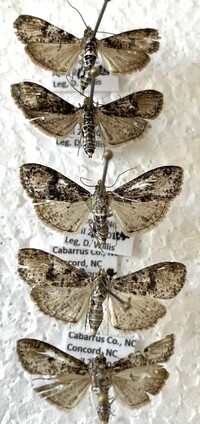Photo Gallery for Palpita aenescentalis - No common name | Photos: 30 |
 | Recorded by: Darryl Willis on 2024-04-21
Cabarrus Co.
Comment: |  | Recorded by: Darryl Willis on 2024-04-21
Cabarrus Co.
Comment: |
 | Recorded by: Darryl Willis on 2024-04-20
Cabarrus Co.
Comment: |  | Recorded by: Rob Van Epps on 2024-04-01
Mecklenburg Co.
Comment: |
 | Recorded by: Emily Stanley on 2024-03-26
Buncombe Co.
Comment: |  | Recorded by: tom ward on 2024-03-21
Buncombe Co.
Comment: |
 | Recorded by: tom ward on 2024-03-20
Buncombe Co.
Comment: |  | Recorded by: tom ward on 2024-03-17
Buncombe Co.
Comment: |
 | Recorded by: tom ward on 2024-03-16
Buncombe Co.
Comment: |  | Recorded by: tom ward on 2024-03-14
Buncombe Co.
Comment: |
 | Recorded by: Stephen Hall on 2024-03-07
Orange Co.
Comment: |  | Recorded by: John Petranka on 2023-03-16
Orange Co.
Comment: |
 | Recorded by: tom ward on 2023-03-09
Buncombe Co.
Comment: |  | Recorded by: tom ward on 2023-03-06
Buncombe Co.
Comment: |
 | Recorded by: tom ward on 2023-03-01
Buncombe Co.
Comment: |  | Recorded by: John Petranka on 2023-02-28
Orange Co.
Comment: |
 | Recorded by: chuck smith on 2023-02-22
Davidson Co.
Comment: |  | Recorded by: tom ward on 2022-03-31
Buncombe Co.
Comment: |
 | Recorded by: John Petranka on 2022-03-26
Orange Co.
Comment: |  | Recorded by: tom ward on 2022-03-21
Buncombe Co.
Comment: |
 | Recorded by: tom ward on 2022-03-17
Buncombe Co.
Comment: |  | Recorded by: tom ward on 2021-04-06
Buncombe Co.
Comment: |
 | Recorded by: tom ward on 2021-04-05
Buncombe Co.
Comment: |  | Recorded by: tom ward on 2021-03-23
Buncombe Co.
Comment: |
 | Recorded by: Jim Petranka on 2020-03-29
Madison Co.
Comment: |  | Recorded by: Jim Petranka on 2020-03-29
Madison Co.
Comment: |
 | Recorded by: Jim Petranka on 2020-03-20
Madison Co.
Comment: |  | Recorded by: Jim Petranka on 2020-03-19
Madison Co.
Comment: |
 | Recorded by: Jim Petranka on 2019-03-30
Madison Co.
Comment: |  | Recorded by: Darryl Willis on 2016-03-11
Cabarrus Co.
Comment: |
|